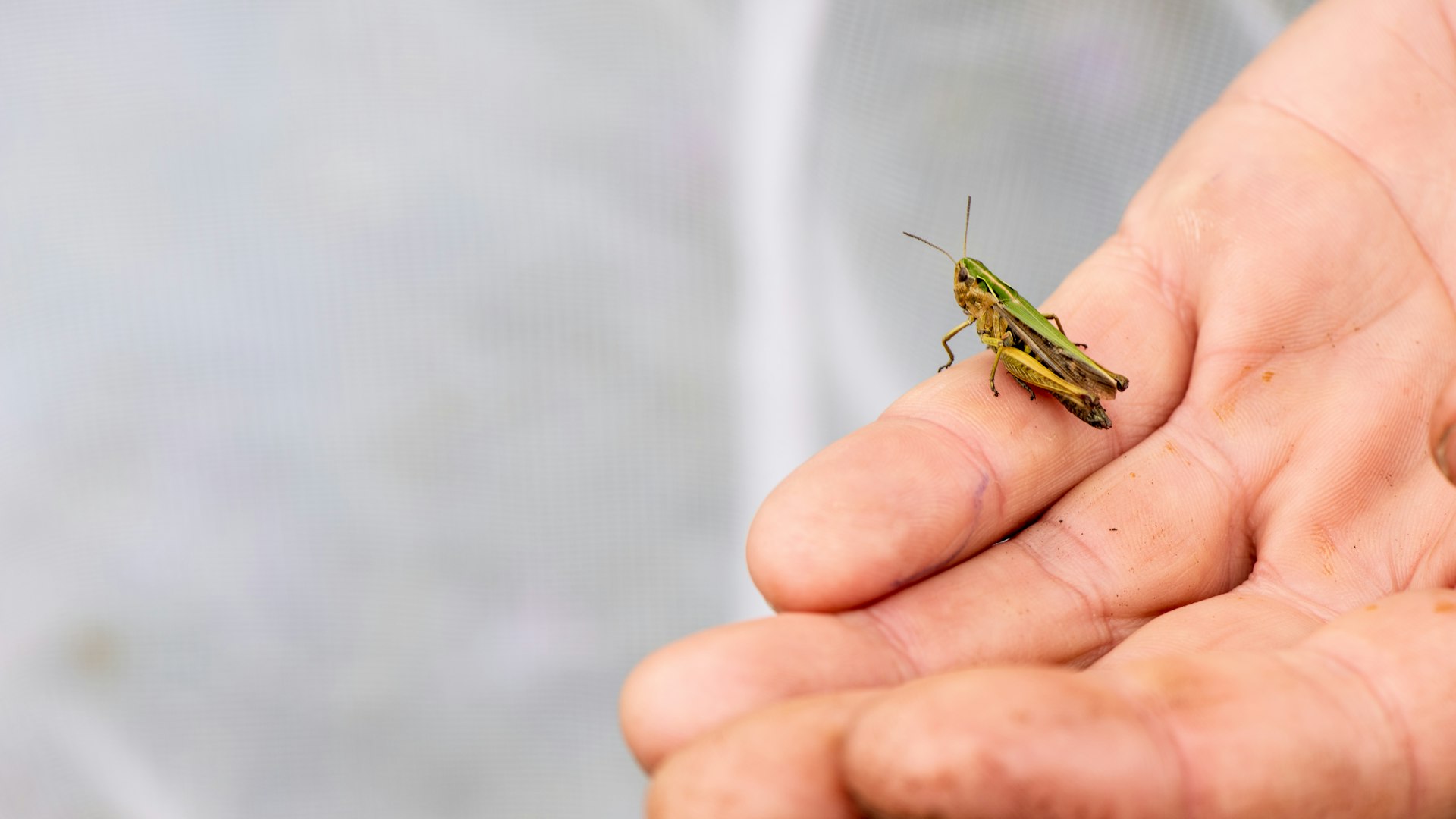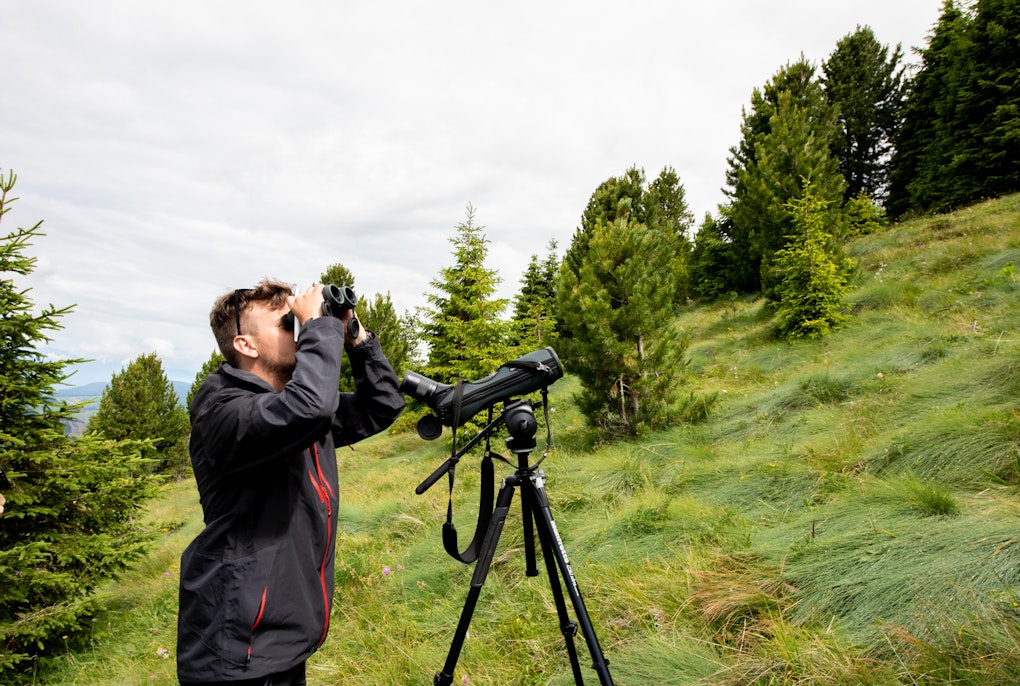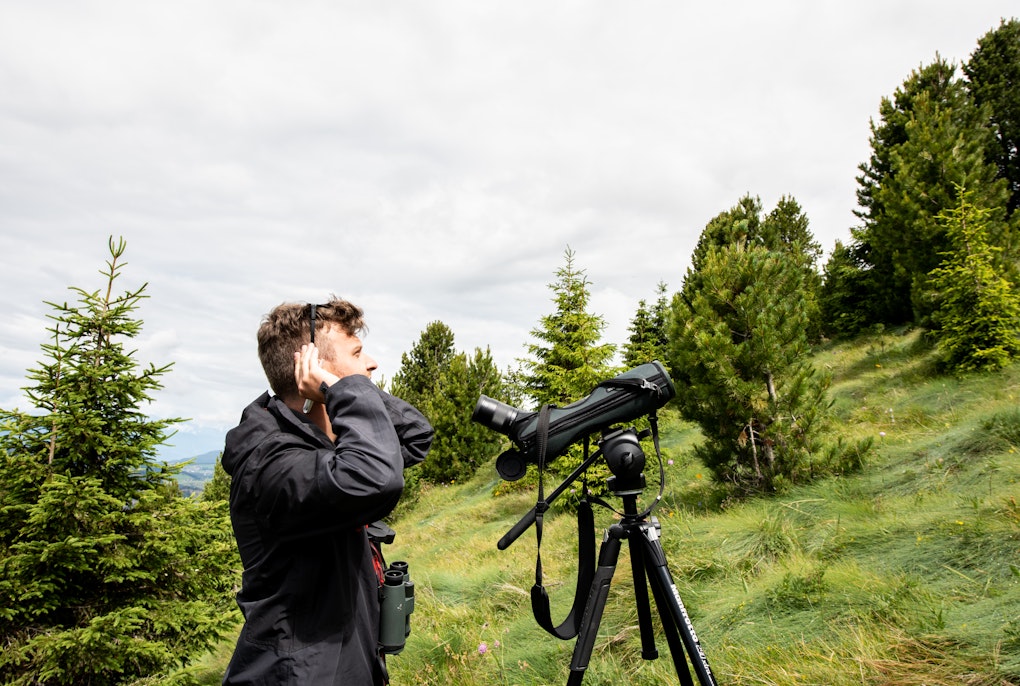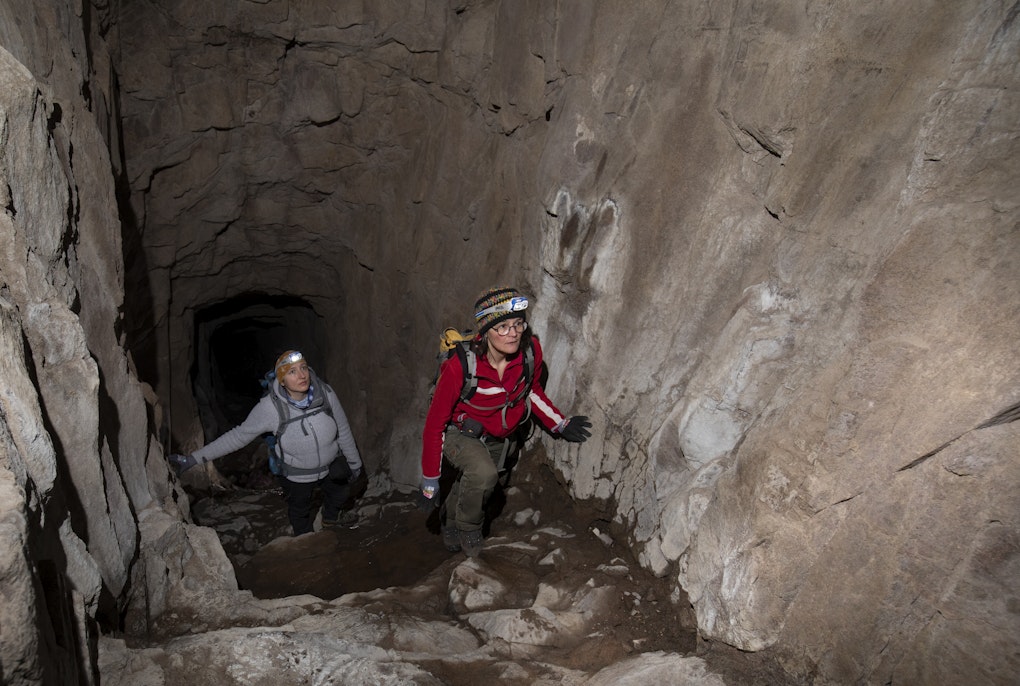Creating a symphony throughout South Tyrol, over 87 different species of grasshoppers populate the region’s meadows, forests, vineyards and orchards. These long-legged insects are strongly tied to their habitats, making them ideal indicators for the biodiversity of a landscape.
No other insect group has as large a musical repertoire as grasshoppers. In summer, males sing to attract females, drive away rivals and mark their territory. Like birds, each species has its own melody, which it produces by scratching its hind legs and wings. In August’s mating season, it gets particularly loud. This is when Andreas Hilpold, a biologist from Eurac Research, goes grasshopper hunting as part of the Biodiversity Monitoring South Tyrol long-term research project.
To select the monitoring area, Andreas Hilpold begins by listening. Relying entirely on his hearing he is able to recognize almost all of the 87 South Tyrolean grasshopper species by their chirps and chirrups alone. He puts his index finger to his lips, the universal gesture for silence. “Cra cra tsch tsch cra brrrrrrrr,” sounds, a bit like someone winding up a toy car on the ground, echo from the meadow. “That's a large banded grasshopper, one of my favorites,” Andreas Hilpold grins. The olive-green and yellow male has a red belly and is about 4cm long. The biologist is especially partial this species because it always chooses particularly beautiful habitats, just like the lush blooming meadow in Venosta’s Roia valley in which Hilpold is using a tape measure to section off 10m².
His other tools for the survey: a net, a pen and a notepad. In the field, he prefers to do without technology. As he systematically nets the ground, he notes the name and number of flying insects, and whether they are adults or juveniles.
In one day, a two-person team can evaluate about five plots, in one year 64. Since the beginning of the Biodiversity Monitoring South Tyrol investigation, 320 areas spread all over South Tyrol have been studied. However, it’s not only insects that are surveyed. The grasshopper part of the survey only takes two weeks. The rest of the time, a variety of mammals, birds, and plants are also counted. Currently there are biodiversity monitoring projects taking place all over Europe, but Switzerland is the definite forerunner and has been monitoring its biodiversity since 2001. Austria has also set up a nationwide biodiversity monitoring project whereby in addition to expert monitoring, anyone can participate in the surveys via a butterfly app. However, South Tyrol has been pursuing one of the most ambitious monitoring projects in Europe for almost five years: covering several animal and plant species, from the valley floor to the mountain peaks, as well as the bodies of water in between.
“Flying insects are loud and numerous and therefore easy to survey. And they colonize all sorts of habitats ̶ from meadows to forests, vineyards and orchards.”
Andreas Hilpold
Certain species groups, including the grasshoppers are examined more closely, Hilpold elucidates. “Flying insects are loud and numerous and therefore easy to survey, if the weather conditions are right that is. And they colonize all sorts of habitats ̶ from meadows to forests, vineyards and orchards.” Even at 2,800 m.a.s.l, Hilpold has seen a few grasshoppers jumping around. As altitude increases their habitats are restricted by the vegetation line: all grasshoppers are herbivores, feeding on grasses and leaves, just some are omnivorous. The latter’s diet includes insect larvae and small caterpillars, and the great green bush-cricket contributes to pest control by feeding on aphids. Different grasshopper species are linked to certain habitats, and their presence or lack thereof, speaks volumes on the quality of a particular location. Hilpold finds ten species in the valley in Roia meadow. In vineyards, there are usually around three. In orchards, often only one, if that. The more intensively an area is used, the quieter it becomes. Grasshoppers are ideal indicators of a habitat’s biodiversity.
Different grasshopper species are linked to certain habitats, and their presence or lack thereof, speaks volumes on the quality of a particular location.
“In addition, grasshoppers form the largest biomass of invertebrates on the alpine region’s ground surface. This makes them an important link in the food chain for birds and small rodents such as shrews, moles, as well as the martens, foxes and wild boars that feed on them,” says Hilpold. And because of this, alongside many other insects, grasshoppers are indispensable for the functioning of Europe’s already endangered ecosystems.
Biodiversity is declining, especially among insects. Back in October 2017, scientists from Krefeld published a study on insect mortality in Germany, where they observed insect populations had declined by more than 75% over a period of 30 years. This is not only bad for birds and a number of mammals, but also for us since 90% of all plants - agricultural crops included - depend on insect pollination. Edward Wilson, the American father of biodiversity who died in 2021, made the following calculation: if all insects and arthropods were to become extinct, our environment would be thrown into chaos and humans would also be wiped out. Andreas Hilpold is not a fan of such apocalyptic scenarios. Biodiversity may not be in good shape, he says, but you don't always have to conjure up the demise of humanity in order to save nature. “For me, protecting biodiversity has an intrinsic benefit. It’s part of my DNA.” And even though biodiversity in South Tyrol may not be in good shape in many places, he goes on to say, “At least there are still numerous landscapes and habitats with very high levels of biodiversity. “Pulling up his net as it whirs and buzzes with insect life, Hilpold cements his statement. Since the beginning of the biodiversity monitoring project in South Tyrol, Hilpold and his team have come across some newcomers to the region: three new grasshopper species, a beneficial insect species that eats aphids called big-eyed bugs (yep that’s their actual name), the greater noctule bat and the strap-leaved earth-moss amongst them. Whether they are new to South Tyrol or had simply been overlooked because they were discovered in areas seldom explored, like Anterivo where two of the new grasshopper species were found, surveys will show in the coming years. In 2024, the researchers will survey the 320 areas for a second time and by the time they are finished, the first time series will be available for comparison. Hilpold observes a trend is already emerging. Heat-loving grasshoppers, like the Common Maquis Grasshopper ̶ native to the Mediterranean region, are spreading, “It may well be that climate change has carried them to more northern regions. And if I can trust my perception, the band-winged grasshopper which also prefers warmer temperatures, has also spread diffusely in South Tyrol in recent years.”
A trend is already emerging. Heat-loving grasshoppers are spreading
One question remains. If biodiversity ̶ at least in parts of the region ̶ is not in such a bad state, why does South Tyrol need a monitoring project? “Areas with high diversity are particularly interesting from a global point of view, and monitoring is a kind of early warning system so that we ensure that we continue to fulfil our responsibility to preserve this diversity in the future,” Hilpold explains. The collected data forms the basis for nature conservation as well as landscape and settlement policies. The Biodiversity Monitoring South Tyrol team also works closely with organic farmers. This data is then constantly fed into the nature museum of South Tyrol’s database where it is fully and freely accessible.
South Tyroleans recently named climate change as one of the greatest threats for the future. Fortunately, we have been collecting data on the subject for centuries. However, systematically collected biodiversity data has only been available for a few decades. Scary; because the biodiversity crisis is at least as dangerous as climate change, according to Hilpold. And though the effort involved in biodiversity monitoring is huge, it’s worth it.
Hilpold also mentions two positive developments: species extinction has been accompanied by a worldwide extinction of taxonomists but now, with the intensified global efforts to stop the biodiversity crisis and, along with it, the monitoring programs that have been launched, specialists like him who can identify animals and plants, are once again being valued.
And, that the EU recently issued a regulation to restore natural areas in Europe. At least 20% of land areas and 20% of marine areas must be restored by 2030. Biodiversity monitoring will provide valuable data on whether such and similar initiatives are successful ̶ so too will the loud and diverse songs of the grasshoppers.





